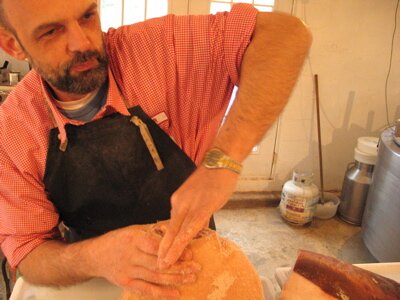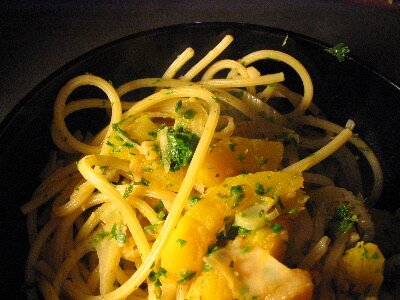
This is Torsten. Torsten currently has his fingers buried as far as they will go in a fresh ham, for reasons I’ll get into in a couple of days. We cut the ham in the German style rather than the American – the ham people tend to think of here has been shaved down to the femur, with the butt and round removed. These hams have the hip bone and knee still attached, and weigh about 30 pounds each. At a guess, half that weight is fat, because these are Tamworth pigs, a heritage breed raised for lard rather than meat. Tamworths are descended directly from the wild boars of Europe, via bloodlines which, according to most experts, have been astonishingly pure. Some believe that the breed was developed purely by selection, and never crossbred for desirable traits. No one can confirm that an outside strain was bred in. They are known as a bacon breed, long bodied and fat.

Pigs with this proportion of fat to lean were common as little as 50 years ago, when there were still people whose need for calories was simply so great that there was no other way for them to get enough energy than by cooking everything with an equal weight of lard. So important an energy source was this, in fact, that it was almost as valuable a commodity as the pork itself, if not more so. The demand for lean meat, the turn away from lard as a cooking fat, and the growth characteristics of most such breeds have made such pigs economically unviable. They mature slowly, and backfat sells at a sixth the price of loin. On the other hand, they forage, and eat pasture, and will grow fat on virtually anything you feed them – a turn of the century farming text gives the recommended diet for these pigs as “less than 1% broken glass.”
Lard, to Torsten, is not simply the fat from a pig, but a specific sort of fat, akin to suet in a cow – the fine, soft white fat from inside the abdominal cavity, which serves as a cushion for the kidneys, known in English cookery as leaf lard. This fat, too soft to do much else with, is rendered, then used as a cooking fat, or stewed with apples and onions then spread on bread. Soft is a relative term. In the late autumn chill, it feels firm as cold butter. Still, though, it’s the wrong consistency for sausage making, and this is what Torsten is after. Torsten is a German master butcher, who can trace the line of butchers in his family back to the 30 Years War. He is also Muslim, having converted, he tells me, in a fit of disillusionment with Christianity and “the lies on which it was built.” Oddly enough, he made this discovery after an intense study of church history, inspired by a period living in what he describes as “the intensely religious Midwest”. At that point, he had been making sausages for 12 years (not counting the years he helped his father as a boy) and giving up either the sale of pork or his religion was entirely out of the question. Since the day he converted, he has not eaten a morsel of pork, though he handles it every hour of his working day.
For sausages, we use the fat beneath the skin, and even that is not a homogenous substance. The fat trimmed off the loin is fatback, the stiffest, hardest fat on the pig. Salted, it becomes lardo, smoked, it is a Ukrainian delicacy. English and American books make a distinction between hard bacon fat and soft bacon fat – the traditional test was to set a cold, hard slab of bacon across two glasses. If it sagged, the fat was soft. Torsten, though, reels off an entire litany - back, neck, shoulder, and breast, jowl… Belly combines very soft fat and medium hard fat. Different sausages use different parts. Today, we will make two kinds of liverwurst, one kind of blutwurst, and something from the offal. But first, we will cut up a pig.
A fairly detailed description of pig butchery in the German pattern follows, with photos.
(more…)




